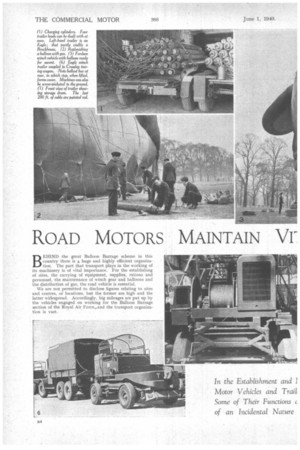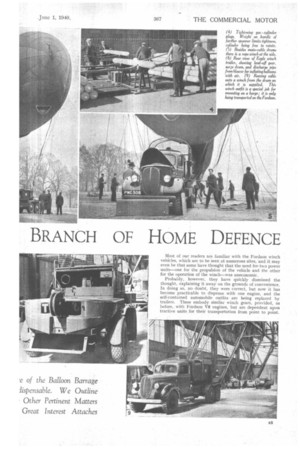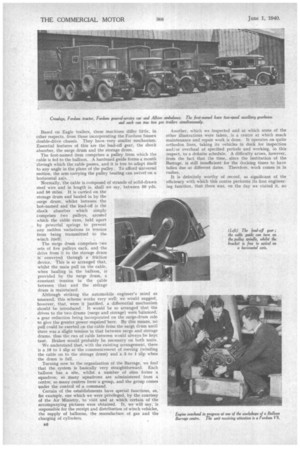ROAD MOTORS MAINTAIN VI BRANCH OF HOME DEFENCE
Page 30

Page 31

Page 32

Page 33

If you've noticed an error in this article please click here to report it so we can fix it.
BEHIND the great Balloon Barrage scheme in this country there is a huge and highly efficient organization. The part that transport plays in the working of its machinery is of vital importance. For the establishing of sites, the carrying of equipment, supplies, rations and personnel, the maintenance of winch gear and balloons and the distribution of gas, the road vehicle is essential.
We are not permitted to disclose figures relating to sites and centres, or locations, but the former are high and the latter widespread. Accordingly, big mileages are put up by the vehicles engaged on working for the Balloon Barrage section of the Royal Air Force„and the transport organization is vast. Most of our readers are familiar with the Fordson winch vehicles, which are to be seen at numerous sites, and it may even be that some have thought that the need for two power units—one for the propulsion of the vehicle and the other for the operation of the winch—was uneconomic.
Probably, however, they have quickly dismissed the thought, explaining it away on the grounds of convenience. In doing so, no doubt, they were correct, but now it has become practicable to dispense with one engine, and the self-contained automobile outfits are being replaced by trailers. These embody similar winch gears, provided, as before, with Fordson V8 engines, but are dependent upon tractive units for their transportation from point to point.
Based on Eagle trailers, these machines differ little, in other respects, from those incorporating the Fordson Sussex double-drive chassis. They have very similar mechanism. Essential features of this are the lead-off gear, the shock absorber, the surge drum and the storage drum.
The first-named item comprises a pulley from which the cable is fed to the balloon. A hardened guide forms a mouth through which the cable passes, and it is free to adapt itself to any angle in the plane of the pulley. To afford universal motion, the arm carrying the pulley bearing can swivel on a horizontal axis.
Normally, the cable is composed of strands of solid-drawn steel wire and in length is, shall we say, between 50 yds. and 50 miles. It is carried on the storage drum and hauled in by the surge drum, whilst between the last-named and the lead-off is the shock absorber which simply comprises two pulleys, around which the cable runs, held apart by powerful springs to prevent any sudden variations in tension from being transmitted to the winch itself.
The surge drum comprises two sets of five pulleys each, and the drive from it to the storage drum is conveyed through a friction device. This is so arranged that, whilst the main pull on the cable, when hauling in the balloon, is provided by the surge drum, a constant tension in the cable between that and the storage drum is maintained.
Although striking the automobile engineer's mind as unsound, this scheme works very well; we would suggest, however, that, were it justified, a differential mechanism should be introduced. It would be so arranged that the drives to the two drums (surge and storage) were balanced, a gear reduction being incorporated on the surge-drum side to give the greater power required'here. By this means, no pull could be exerted on the cable from the surge drum until there was a slight tension in that between surge and storage drums, thus the run of cable between would always be kept taut. Brakes would probably be necessary on both units.
We understand that, with the existing arrangement, there is a 16 to 1 slip at the commencement of reeving (winding the cable on to the storage drum) and a 3 to 1 slip when the drum is full.
Turning now to the organization of the Barrage, we find that the system is basically very straightforward. Each balloon has a site, whilst a number of sites forms a squadron; so many squadrons are administered from a centre; so many centres form a group, and the group comes under the control of a command.
Certain of the establishments have special functions, as, for example, one which we were privileged, by the courtesy of the Air Ministry, to visit and at which certain of the accompanying pictures were obtained. It, we will say, is responsible for the receipt and distribution of winch vehicles, the supply of balloons, the manufacture of gas and the charging of cylinders. Another, which we inspected and at which some of the other illustrations were taken, is a centre at which much maintenance and repair work is done. It operates on quite orthodox lines, taking its vehicles in dock for inspection and/or overhaul at specified periods and working, in this respect, to a definite schedule. A difficulty arises, however, from the fact that the time, since the institution of the Barrage, is still insufficient for the docking times to have fallen due at different dates. Therefore, work comes in in rushes.
It is definitely worthy of record, as significant of the efficiency with which this centre performs its first engineering function, that there was, on the day we visited it, no single winch vehicle in for repair. Without a winch there cannot be a balloon. Balloons must be always ready. We saw no winch vehicle out of commission. Full marks No. X centre!
Much of the transport is done, inevitably, during the black-out, and a big proportion of it is urgent. Minor crashes are, therefore, hard to avoid. However great may be the efforts to enforce the speed-limit regulations. scraped wings and such-like cannot be wholly eliminated. In this connection we suggest that the semi-Circular hole and darkened reflector, still exclusively used on the vehicles in this service, are definitely inferior in illumina.ting power to the best types of mask used by civilian drivers.
In emergency, we understand, the service driver may possibly be permitted to drive with undimmed head lamp and may need to make the alteration quickly. If this be used as an argument against the employment of a mask, then let the masks be hinged. The absence of a glass matters nothing in circumstances of temporary urgency.
Reverting to the main matter, however, it is obvious that the manufacture and the distribution of gas is of great moment. It is made, and cylinders are charged, at a number of establishments throughout the country, trailers with loads of empty cylinders coming in, being charged and conveying them to centres, sites, etc. Fordson, Crossley and Albion tractive units are largely employed for towing them, commonly two at a time in the case of the more powerful vehicles.
Gas manufacture is by the water-gas and ferric-oxide pro cess, and some fine equipment is employed. For the first operation, apparatus differing in principle little from the vehicle gas producer, with which we are becoming so familiar, is used, steam being blown through hot coke, intermittently with air, to produce the mixture of hydrogen and carbon monoxide needed for the further gas-making and heat-generating operations.
It is stored in holders from which a battery of electrically driven Reavel 4-stage WO cubic-ft. compressors pump it into the cylinders, of which some 120 can be charged simulta neously.
Steam boilers, retorts, furnaces, purifiers, blowers, pumps, exhausters, meters, all go to comprise the gas works. It is outside the field of this paper, but we mention it to show the extensiveness of the Barrage organization.
The cylinders hitherto have been carried almost exclusively on Brockhnuse torsion-bar-sprung trailers; now, however, Eagle trailers, with ordinary leaf springs are being used also.
In addition to the machines already enumerated, the Section operates utility vehicles, ambulances, general-service wagons, breakdown vans, and other types, makes that we observed including Albion, Commer, Crossley, Fordson, Hillman and Karrier. All come under the charge of the various repair centres and appeared to us to be very well maintained. To help this work, a. high degree of co-operation is called for with the various manufacturers, particularly in order to avoid long delays resulting from the need for spares. Their difficulties axe considerable, and they receive equally urgent demands from many quarters. They may even be tempted to regard the Balloon Barrage as of less importance than other sections of the Services, but any such differentiation is surely unwise.
Its work is of very great importance, and is right here among us.
Also required for carrying it on is a large number of men. Shortage of personnel is another handicap that is .having to be contended with. Recruits are badly needed for the Barrage.
by the Balloon




























































